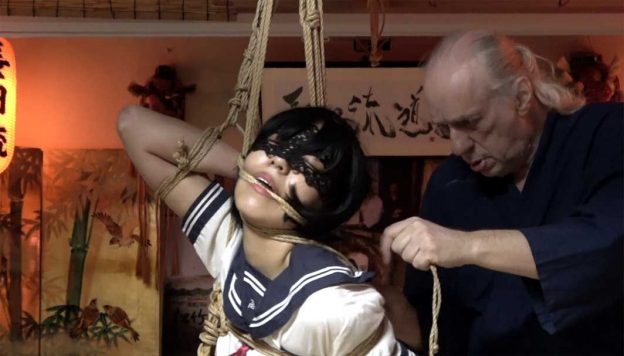A little while ago, I announced that we had posted the first full-length Osada-ryu tutorial, ‘The Secrets of Floorwork (Newaza)’; now, we have more kinbaku tutorials from Osada Steve.
‘The Secrets of Floorwork (Newaza)’ has now become ‘The Secrets of Floorwork: Part I’ as we have now uploaded ‘The Secrets of Floorwork: Part II’ which continues with Aisatsu shibari (挨拶縛り: Greeting ties) in Yukimura’s caressing style floorwork. Due to the interest this series is generating, we already have Part III, in production.
‘The Secrets of Floorwork: Part II’

Aisatsu shibari (greeting shibari) is designed to gauge the overall readiness of your rope partner for an emotional exchange and, therefore, for a deeply satisfying session. As with other Yukimura-based techniques, these ties are designed to gently open a dialogue with your partner to establish the most appropriate approach and to align the session with their desires to maximise the emotional exchange.
You will learn how to approach these ties with humility and loving kindness your partner will naturally feel inclined to reciprocate and open their heart to you. Do not be misled by the technical simplicity of these ties. Good shibari sessions are not about the amount of rope or the complexity of the pattern. Kinbaku is like an iceberg, most of it is hidden from plain sight; it is all about how you do even the most simple ties.
The devil is in the detail
The simplicity of these one-rope ties, although incorporating skills usually only taught at a very advanced level, means they are well within the grasp of the novice. These techniques are the most important foundations for connective rope as they can be applied to any tie, regardless of its complexity. Without such nuances, you are likely to only creating restraint and patterns, thus missing out on the real essence of the art.
This is tutorial builds upon ‘The Secrets of Floor-work: Part I’ and expands on the techniques shown there.
More shibari tutorials to come
Inspired by the reception of his first tutorial, plus the constraints on face to face teaching and shows due to the pandemic, Osada Steve has gone into turbo mode. I have tutorial material from him backing up waiting to be edited! The next is Teppozuri, the iconic rifle carrier suspension. I will make another post about that.

Technical improvements
We appreciate that the audio and camera techniques can be improved. However, Steve’s studio is very close to the railway lines of Ikebukuro station and a busy intersection, so a certain amount of natural Tokyo ambience is inevitable. He isn’t used to recording, so we have had a few glitches to iron out. We have addressed things like his natural soft-spokeness, the noisy heater/air con unit and camera technique is improving. The important thing is the content is there. It is the depth and nuance which is conveyed that gives the value.
Currently, these tutorials are a diamond in the rough but, be assured, we are polishing them for the future. Steve has promised to buy a better mic so we can get it closer to minimise to external sounds and a second camera is on the shopping list.

